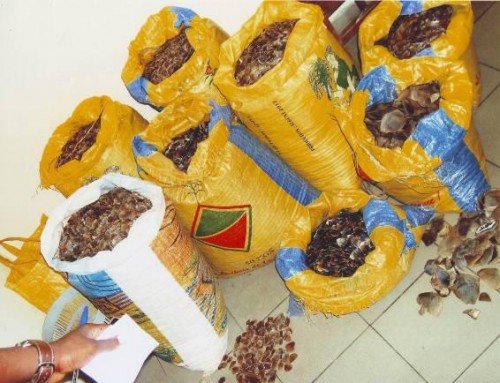
It seems that no pangolin population is safe from the deadly illegal trade: During the final ten days of April 2013, pangolins and scales were seized in the Philippines, India, Cameroon, and France.
On April 20th — just days after the shocking discovery of 2,000 frozen pangolins on a Chinese fishing vessel which ran aground in Tubbataha Reefs Natural Park — the Philippine Coast Guard seized another 23 pangolins from a cargo ship at the port of Coron. A tip-off prompted the PCG to search the M/V Maria Lydia, a Philippine vessel owned and operated by JCAP Shipping Lines and with a business address in Coron, Palawan. 22 of the pangolins were still alive at the time.
According to GMA News, the Maria Lydia’s skipper, Menandro Fabul, claims that he did not know who “left the anteaters” on the ship. However, Coast Guard Palawan head Commodore Enrico Evangelista is “not satisfied with the claim” and the PCG plans to press charges against Fabul.
Also on April 20th, a suspect identified as “Shakeel” was arrested and 11 kg of pangolin scales were seized in Uttar Pradesh, India. The suspect is “alleged to be a member of an international gang” involved in the trafficking of endangered species. Using an average weight for Asian pangolins of seven kilograms and scales comprising 20 percent of a pangolin’s weight, this seizure represents approximately eight pangolins.
Then on April 29th, the Cameroon-based wildlife law enforcement NGO LAGA reported that seven sacks (updated 08/01/2013: 80 kg) of pangolin scales had been seized in Limbe. A Cameroonian and a Chinese national were arrested. Founder of LAGA and author of The Last Great Ape, Ofir Drori, says that “the trade in pangolin scales is booming” in the region. He informed Annamiticus that the Chinese national had attempted to “conceal the sacks into three carry-on suitcases”.
The next day, 50 kg (110 lbs) of pangolin scales (also from Cameroon and apparently headed to Vietnam) were intercepted by customs authorities at the Charles de Gaulle airport in Paris. Using an average weight for African pangolins of 11 kg and scales comprising 20 percent of a pangolin’s weight, the haul represents approximately 23 pangolins. This was reportedly the third seizure of scales at CDG in April 2013, and the sixth since 2009.
Meanwhile, the thousands of pangolin carcasses found aboard the Chinese ship in April 2013 will be destroyed. Alex Marcaida, the information officer at the Palawan Council for Sustainable Development, told The Wall Street Journal that a court order was necessary for the disposal because the ship is considered evidence against the 12 Chinese suspects.
The thousands of frozen anteaters on the Chinese vessel have been thawing, creating a stench and potential health hazard. They will be buried in the outskirts Palawan’s main city of Puerto Princesa.
Five of the 400 boxes containing dead pangolins were sent for sampling. Initial tests show that at least two pangolin species were killed — the Philippine pangolin (Manis culionensis) and the Sunda pangolin (Manis javanica), found throughout Southeast Asia.
[The Philippine pangolin] is protected under a ban on the collection of any form of wildlife in the Province of Palawan, the entire province having been declared a game refuge and bird sanctuary in 1969.
All eight pangolin species are listed in CITES Appendix II, 4 with zero export quotas for wild collected specimens.
Between 2011 and 2013 (A/O April 20), we estimate that between 89,020 and 178,040 pangolins were destined for the black market. Pangolins — even whole fetuses — are eaten as a delicacy in China and Vietnam. Their scales are also a prized ingredient in traditional Chinese medicine, although the scales are comprised simply of keratin, like human nails and hair.
And finally, one fortunate pangolin in Sri Lanka will live to see another day. The pangolin was rescued by wildlife officials after being contacted by a local villager who said his dogs had found the animal near his home. Wildlife authorities released the pangolin in Hiyare Forest Reserve.

![Pangolin Trafficking: 2011 to August 2013 [Infographic]](https://annamiticus.com/wp-content/uploads/2013/08/PangolinsInTrade2011thruAugust2013-150x150.jpg)
![Pangolin Trafficking: 2011 to April 2013 [Infographic]](https://annamiticus.com/wp-content/uploads/2013/04/PangolinsInTrade2011thru2013-150x150.jpg)

